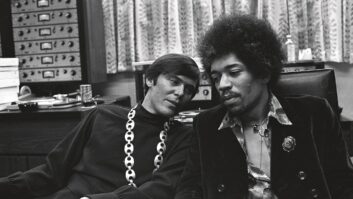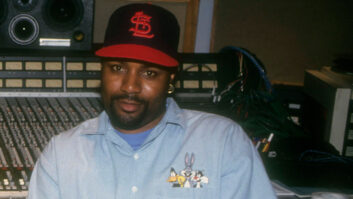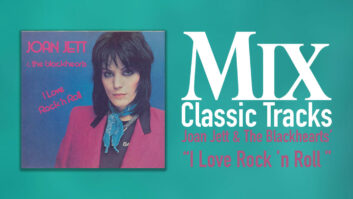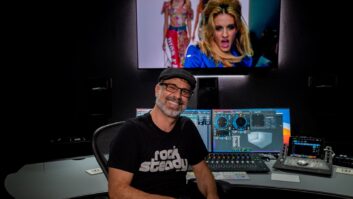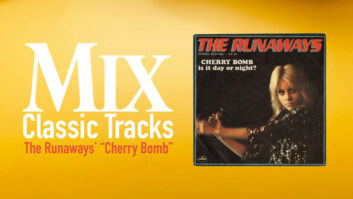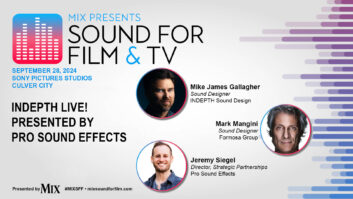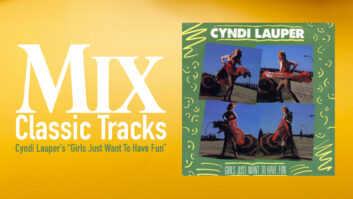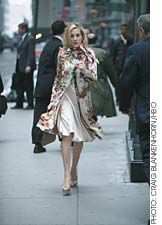
TV can be a sensual experience, and very few shows appeal to theeyes — and ears — more than HBO’s Sex and the City.Although the alluring leading ladies, sharp story lines and racy titleget most of the credit for the show’s multiple Emmy Awards and a hugefollowing, superior production values are key to making Sex and theCity such an attractive package. Supplementing the show’s richvisual style is a crystalline, punchy and enveloping audio experiencethat’s among the very best on television today, created since seasonone at New York’s Soundtrack Film & Television by a tight-workingsound editing team that is overseen by mixer Bob Chefalas.
KEEPING THE AUDIO REALISTIC
“We take a lot of pride in the fact that the same productionand sound mixing crew have been on the show from the start,”Chefalas says. “What we do that’s different from a lot of TVshows is we treat each mix as if it’s a reel of film. Everything’scovered, in that we give it a full sound, whereas other TV shows don’tget the time to do that. Plus, we don’t have a laugh track: Everythingis dialog, music and effects.”
Supervising sound editor Chic Ciccolini agrees that the Soundtrackcrew has something special going for Sex. “What makes ourshow great,” he says, “besides the writing, is that we puteverything we do into the screen. Nothing comes at you unrealistically,unless it’s designed to do so, but, otherwise, everything is blendedand mixed so well. We don’t want you to think, ‘Here’s a carhorn,’ or ‘Here’s a bus-by.’ We’re not saying,‘Okay, audience, here it is!’”
While Chefalas is the mastermind behind the mix, as he’s been sincethe show’s first season, he has plenty of sonic support from veteranslike supervising sound editors Ciccolini (sound effects), Louis Bertini(dialog) and Dan Lieberstein (music). Making things even better istheir brand-new facility in New York City’s fashionable Chelseaneighborhood. The studio boasts two mix stages and an ADR/Foley stage,which provides the team with the perfect environment to craft theshow’s sound.

VOICE-OVER CHALLENGES
Working with a Pro Tools front end and a Euphonix System 5 digitalaudio console in his spacious, Jeff Cooper-designed stage, Chefalas hasthe process of mixing Sex down to a science. His multiple TV and filmcredits include features such as Apollo 13, Ransom, EDtv andDude, Where’s My Car? under his belt, so Chefalas knows dialogand, naturally, it gets top priority. “Whether it’s a TV show orfeature film, the first thing I want to do is a dialog mix,” saysChefalas. “Sex and the City has a lot of voice-over, and Imix it in the whole show in its entirety, going to each spot wherethere’s a VO and mixing and EQ’ing it at the normal VO level frombeginning to end. I found that if something came in later, I wasn’talways consistent, so [now] I go right from beginning to end and recorddialog at the same time. I also get VOs that were recorded in more thanone location: You may have a VO split in half, a pickup line and a newlocation from a different studio, different room, different mic andlevels, so you’ve got to treat it so that it sounds thesame.”
Careful handling of the voice-overs of Sarah Jessica Parker, playingthe part of sex columnist and narrator Carrie Bradshaw, is a crucialtask that calls for restraint, good taste and precise handling ofcompression. “We don’t treat [voice-overs] like on radio, wheresometimes you might want to take a VO, put it over the top and make itreally big,” he says. “I try to make the VO a part of theshow, not above it, almost like production dialog. It’s just aprocessing thing: You don’t want to overprocess it or add a lot ofbottom to it. You want to hear it loud and clear. Sarah has got a verysweet, nice, smooth voice, and you don’t really want to do a lot to it.It mostly comes down to compressing and containing it, but you don’twant to overcompress it. It has to pop through TV speakers, so you findthe frequencies that are little delicacies, reach for it, and that’swhat brings the VO to life.”
Chefalas is willing to share his secret weapons for getting a cleansound: “The Waves L2 UltraMaximizer is a secret in thisindustry,” he says. “In mastering, you can feed musicthrough it, contain it and still make it sound loud. I use that on mydialog to give it extra punch, but it won’t go past what they’ll allow.The compressors on-air won’t start compressing my dialog, so I canlimit my dynamic range and not make it overly loud. I use a combinationof that and the Neve 33609 as a soft compressor, which, with a 2:1ratio, is smoothing out the dialog and not overly compressing it. Thenthe L2 will hit and contain any of the peaks.”
MAINTAINING CLARITY IN PRODUCTION DIALOG
On the first day of a four-day mix, Chefalas turns his attention tothe production dialog. Capturing that on New York’s bustling streetsbrings its own set of hurdles. Although the multiple location shotsprovide plenty of challenges with their varied camera angles and micsetups, that’s not the toughest aspect of this phase. “You’ve gotto smooth out the traffic,” notes Chefalas. “The most workyou will do is on exterior scenes in Manhattan, because you can’t stopthe traffic and you’ve got to get the dialog out.
“Then there’s scenes shot on sets, but we don’t want it tosound like a set, so you add a little room to it with reverb, primarilythe TC Electronic 6000. It’s also taking out noises, because in asupermarket or restaurant, you’ll end up with AC noise and fluorescentlight hums and you have to notch that out.”
When Chefalas comes in and fires up the system the next day, it’stime to attack the ADR and loop group, adding backgrounds of peopletalking and forks clinking, all done with unusual attention to detail.“There are a lot of phone calls, for instance, and you’ve got totreat each phone differently,” he says. “I’ve tried boxesthat can make it sound like a phone, but I’ve found those make everyphone sound the same. I’ll bring it through the System 5, use ahighpass/lowpass filter, find out if it’s a cell phone, answeringmachine, etc…, and then compress and squeeze it down a lot. Ihave presets to start off with, but each phone is a little different,even though it takes a little longer than plugging in a box.
“It’s the same thing when we go to restaurants. Every show hasa diner scene, but we don’t just copy and paste a diner background:Each one gets treated like new, with new ADR, new loop group, newbackgrounds. For one diner scene, we may have six tracks of loop group:the dialog, dish clinks, silverware clinks, background traffic noiseand Foleys for all of the movement going on. The diner’s activity comesout of the emotion of the dialog. If it’s a very upbeat, fast-paceddialog back and forth, you’ll find a very lively background, but ifit’s a very serious piece of dialog, we’ll treat it accordingly. Youdon’t want all these happy people in the background for a sadscene.”
ADDING EFFECTS, FINALIZING THE MIX
The next two days are spent finalizing the music, sound effects anddialog mix, with Foley coming in last. Then it’s time to play back forthe editors and producer Antonia Ellis, get their notes, tweak and do afinal playback for executive producers Michael Patrick King, CindyChupack, John Melfi and Jenny Bicks. During the playbacks, Ciccoliniand Bertini work at Pro Tools stations that flank the System 5 forup-to-the-second changes and easy collaboration. A 5.1 mix is generatedwith minimal fuss from the stereo mix via Dolby surroundalgorithms.
With almost 100 inputs to fuse together in a typical show, Chefalasdepends on a surprisingly tight gear list to do his job. Supplementingthe previously mentioned compressors and effects, for noise reductionhe uses Cedar DNS1000 and Dolby 430 Background Noise Suppressor. An SPLDe-Esser, dbx compressors, Avalon Vt737sp and Eventide HarmonizerOrville are also at work. Monitoring comes through Auratone monitorsand his new fave-rave, the HHB Circle 3. “I found that my EQcurve is matched closer to my film speakers, which are JBL theaterspeakers. They’re a couple of notches better than the Auratones, butnot overpowering to have on the console; small, but with a really bigsound.”
Now in his second season with the Euphonix System 5, Chefalas findsit gives him a lot of what he needs for both film and TV work. “Ilike the sound of the console, as well as the visual feedback,”he says. “For example, when you go to EQ, you get a curve on thebridge that tells you where it is, so you can go down the board and seewhat the EQ is doing, and you don’t have to read the knobs. It’s thesame for dynamics: As you start doing the threshold, you can see theknees and where it’ll start to hit it.”
Chefalas finds that he works at the same pace whether his console isdigital or analog: “Reaching for an EQ and finding it takes thesame amount of time on analog or digital. The beauty of the Euphonix isit will back up and automate any busing, EQs and dynamics and rememberyour moves, so when you go back to make changes, it’s all there foryou.”
Although Sex and the City is now in its final season,Chefalas and crew don’t have to wonder what they’re going to do next.The mixing stage at Soundtrack F/T is already booked with feature-filmwork through January 2004, meaning that Chefalas will continue to havehis hands full with faders and cue sheets. For a mix engineer withsharp ears, that’s as sexy as it gets.
David Weiss, founder ofwww.dwords.com, writes and records as much ashumanly possible in New York City.
